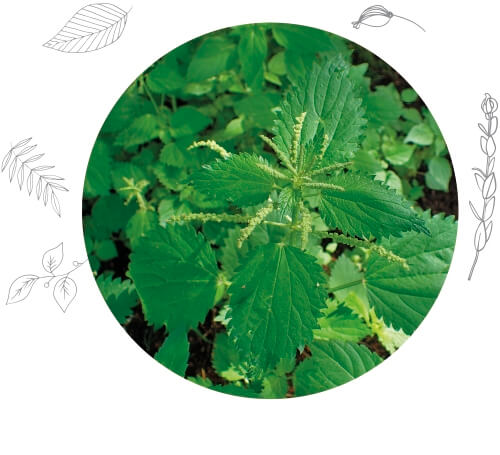-
Free Shipping in Greece over €30!

-
Shipping within 24 hours!

-
Worldwide shipping!



NETTLE
The nettle, well-known since the ancient times, was Hippocrates' most commonly used herb. It is a native wild plant with four species in Greece. Nettle energizes the body by increasing red blood cells, increasing diuresis and lowering blood pressure.
Name - Species
Nettle is an herb known since the ancient times and one of the most commonly used by Hippocrates. Other names are: tsouknitha, anginitha, akalifi, urtiki, etc. It is grown in residential areas, uncultivated soils, hedges and nitrogen-rich soils. Its Latin name urtica which was given by Plinius because of the burning and the itch that characterizes it.
Nettle belongs to the group (clade) of Angiosperm plants, in the family of Urticaceae, genus Urtica. It is a one-year or perennial, herbaceous, native plant, with about 40 species worldwide. In Greece there are four species: Urtica dioica (the two-sexes nettle), the most common species, Urtica urens (the burning nettle), Urtica membranacea (the membranous nettle) and Urtica pilulifera (nettle with spheres).

Urtica dioica
Botanical description
An herbaceous plant, perennial, common in the Greek countryside. It grows naturally in mountainous areas, provided there is humidity. Its stem reaches a height of 1 meter while its flowers are small and odorless. The entire plant is covered by glandular bristles that cause itching upon contact with the skin. This is due to a compound contained in the fine needles but which are destroyed by boiling or baking. It blossoms during the summer.

Urtica urens
History
The properties of nettle were first documented by Chrysippus, Aristophanes and Hesiodus. Hippocrates was the first to list the nettle among the "panacea" plants (they are appropriate for many uses) and recommended the nettle for the treatment of 61 diseases. The Greek physician Galenos in his book "De Simplicibus Medicamentis ad Paternainum (espurio)" recommended the nettle for the treatment of many diseases.

Urtica membranaceous
Pharmacological Properties
Nettle has many pharmacological properties, the most important of which is the energizing of the organism. This is achieved by increasing red blood cells, increasing diuresis and reducing the systolic pressure.
Nettle leaves and stems extract relieves fatigue or anaemia, which is characterized by general muscle weakness, exhaustion, cognitive difficulties and headaches. The combination of high vitamin C and iron content in nettle extract stimulate red blood cell (RBC) production. Vitamin C optimizes iron uptake in the gut, while iron is a crucial component of hemoglobin. By increasing the RBC count in the body, circulation increases and the body’s extremities receive essential oxygenation to boost energy levels.
Nettle extract is an ideal diuretic, due to its high potassium content. Research has also revealed that nettle extract can help lower systolic blood pressure and relieve tension and stress on the cardiovascular system.
Bibliography
1. Laban K. Rutto, Yixiang Xu, Elizabeth Ramirez and Michael Brandt. Mineral Properties and Dietary Value of Raw and Processed Stinging Nettle (Urtica dioica L). International Journal of Food Science, Volume 2013 (2013).
2. Ozen, T., Korkmaz, H., 2003. Modulatory effect of Urtica dioica L. (Urticaceae) leaf extract on biotransformation enzyme systems, antioxidant enzymes, lactate dehydrogenase and lipid peroxidation in mice. Phytomedicine 10, 405-415.
3. Buettner, C., Mukamal, K. J., Gardiner, P., Davis, R. B., Phillips, R. S., and Mittleman, M. A. Herbal supplement use and blood lead levels of United States adults. J.Gen.Intern.Med. 2009;24(11):1175-1182.
4. Daher, C.F., Baroody, K.G., Baroody, G.M., 2006. Effect of Urtica dioica extract intake upon blood lipid profile in the rats. Fitoterapia 77, 183-188.
5. Barlow, R. B. and Dixon, R. O. Choline acetyltransferase in the nettle Urtica dioica L. Biochem J 1973;132(1):15-18.
6. Toldy A, Atalay M, Stadler K, et al. The beneficial effects of nettle supplementation and exercise on brain lesion and memory in rat. J Nutr Biochem . 2009;20(12):974-981.
7. Toldy A, Stadler K, Sasvári M, et al. The effect of exercise and nettle supplementation on oxidative stress markers in the rat brain. Brain Res Bull . 2005;65(6):487-493.
8. Chaurasia N and Wichtl M. Sterols and steryl glycosides from Urtica dioica. Journal of Natural Products 1987;50(5):881-885.
9. Chrubasik, J. E., Roufogalis, B. D., Wagner, H., and Chrubasik, S. A. A comprehensive review on nettle effect and efficacy profiles, Part I: herba urticae. Phytomedicine. 2007;14(6):423-435.
10. Dar SA, Ganai FA, Yousuf AR, et al. Pharmacological and toxicological evaluation of Urtica dioica. Pharm Biol 2013;51:170-80.
11. Wagner H, Geiger WN, Boos G, and et al. Studies on the binding of Urtica dioica agglutinin (UDA) and other lectins in an in vitro epidermal growth factor receptor test. Phytomedicine 1995;4:287-290.
12. Teucher, T., Obertreis, B., Ruttkowski, T., and Schmitz, H. Cytokine secretion in whole blood of healthy subjects following oral administration of Urtica dioica L. plant extract. Arzneimittelforschung. 1996;46(9):906-910.
13. Kraus R, Spiteller G, and Bartsch W. (10E,12Z)-9-Hydroxy-10,12-octadecadienoic acid, an aromatase inhibitor from roots of Urtica dioica. Liebigs Ann Chem 1991;335-339.
14. Pinelli P, Ieri F, Vignolini P, Bacci L, Baronti S, Romani A. Extraction and HPLC analysis of phenolic compounds in leaves, stalks, and textile fibers of Urtica dioica L. J Agric Food Chem . 2008;56(19):9127-9132.
15. Ganzera M, Piereder D, Sturm S, Erdelmeier C, Stuppner H. Urtica dioica agglutinin: separation, identification, and quantitation of individual isolectins by capillary electrophoresis and capillary electrophoresis-mass spectrometry. Electrophoresis . 2005;26(9):1724-1731.
16. El Haouari M, Bnouham M, Bendahou M, et al. Inhibition of rat platelet aggregation by Urtica dioica leaves extracts. Phytother Res . 2006;20(7):568-572.
17. Harput US, Saracoglu I, Ogihara Y. Stimulation of lymphocyte proliferation and inhibition of nitric oxide production by aqueous Urtica dioica extract. Phytother Res . 2005;19(4):346-348.
18. Yener Z, Celik I, Ilhan F, Bal R. Effects of Urtica dioica L. seed on lipid peroxidation, antioxidants and liver pathology in aflatoxin-induced tissue injury in rats. Food Chem Toxicol . 2009;47(2):418-424.
19. Golalipour MJ, Khori V. The protective activity of Urtica dioica leaves on blood glucose concentration and beta-cells in streptozotocin-diabetic rats. Pak J Biol Sci . 2007;10(8):1200-1204.
20. Tahri, A., Yamani, S., Legssayer, A., Aziz, M., Mekhfi, H., Bnouham, M., Ziyyat, A., 2000. Acute diuretic, natriuretic and hypotensive effects of a continuous perfusion of aqueous extract of Urtica dioica in rats. J. Ethnopharmacol. 73, 95-100.
21. Testai L, Chericoni S, Calderone V, et al. Cardiovascular effects of Urtica dioica L. (Urticaceae) roots extracts: in vitro and in vivo pharmacological studies. J Ethnopharmacol . 2002;81(1):105-109.
22. Legssyer A, Ziyyat A, Mekhfi H, et al. Cardiovascular effects of Urtica dioica L. in isolated rat heart and aorta. Phytother Res . 2002;16(6):503-507.
23. Shackebaei D, Godini A, Abolghazi M, Majnouni M, Hesari M. Protection of ischemic and reperfused rat heart by aqueous extract of urtica dioica. Iran Cardiovasc Res J 2010;4:107‑11.
24. Alisi CS, Emejulu AA, Nwagou LA, Onyema OO. Decreased cardiovascular risk and resistance to hyperlipemia‑induced hepatic damage in rats by aqueous extract of Urtica dioica. Afr J Biochem Res 2008;2:102‑6.
25. Dizaye K, Alberzingi B, Sulaiman S. Renal and vascular studies of aqueous extract of Urtica dioica in rats and rabbits. Iraq J Vet Sci 2013;27:25‑31.
26. Testai L, Chericoni S, Calderone V, Nencioni G, Nieri P, Morelli I, et al. Cardiovascular effects of Urtica dioica L. (Urticaceae) roots extracts: In‑vitro and in‑vivo pharmacological studies. J Ethnopharmacol 2002;81:105‑9.
27. Legssyer A, Ziyyat A, Mekhfi H, Bnouham M, Tahri A, Serhrouchni M, et al. Cardiovascular effects of Urtica dioica L. in isolated rat heart and aorta. Phytother Res 2002;16:503‑7.













